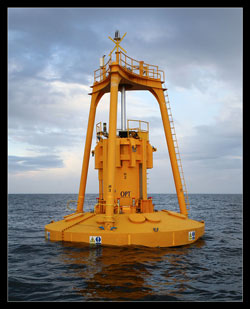Advancing the availability of alternative energy solutions reaps the benefits of protecting the environment, promising future generations a reliable energy supply, creating jobs to improve the economy, and most importantly, enabling energy independence to reduce the dependence on foreign sources.
On Feb. 11, Lockheed Martin signed a contract with Victorian Wave Partners Ltd. to signal the construction of the biggest wave energy project in the world to date, marking an important step forward in harnessing the energy of ocean waves.
Headquartered in Bethesda, Md., Lockheed Martin is a global security and aerospace company that employs about 115,000 people worldwide and is principally engaged in the research, design, development, manufacture, integration and sustainment of advanced technology systems, products and services, according to lockheedmartin.com.
Even though the 62.5-megawatt peak power energy project will be constructed off the coast of Australia, the effects of its “PowerBuoy” wave energy converter technology will be felt worldwide. Once the endeavor nears completion, it is expected to be able to produce enough energy to supply the requirements of 10,000 homes.
“We are applying our design and system integration expertise to commercialize promising, emerging alternative energy technologies, including ocean power,” said Tim Fuhr, Director of Ocean Energy for Lockheed Martin’s Mission Systems and Training business. “This project extends our established relationship with [Ocean Power Technologies] and Australian industry and enables us to demonstrate a clean, efficient energy source for Australia and the world.”
Dr. Zachary Kudlak, assistant professor of mathematics, said, “I am not an expert on tidal energy, but it seems that tidal motion is dependable, and could be a sustainable power source. I think that with wind and solar energy, there is always a problem with what to do when the wind is calm, or when there are extend periods of dark and cloud weather.”
Kudlak added, “Humans will still have power needs during these times, and so we currently need to have the production capabilities that are independent of the weather.”
Wave energy converters like the PowerBuoy system used by Lockheed Martin work by extracting energy from the motion of waves at the ocean’s surface. Due to the rather predictable nature of ocean waves, their mechanics can be quantified easier than those of other alternative energy sources like wind or solar energy. This consequently allows wave power devices to be able to run more efficiently and generate energy for longer periods in the year than their solar or wind counterparts.
Furthermore, PowerBuoy wave devices are visually unobtrusive given that they are only 30 feet in height above the water surface and three miles offshore, compared to wind turbines which can be upwards of 130 feet in height, according to lockheedmartin.com.
Inside the energy convertor, a piston-like structure moves as the PowerBuoy bobs in response to the rise and fall of ocean waves. This oscillating motion is the driving force behind a generator that produces electricity which is subsequently relayed to the shore with the use of an underwater cable. By constructing a series of such energy convertors in parallel, wave power plants can be optimized to deliver low-cost electricity to meet desired power capacities.
To mitigate concerns of such offshore activity on sea life, especially in the cautionary aftermath of the BP oil spill in 2010, an independent Australian study found that the OPT PowerBuoy had “no negative impact on sea life, including migratory patterns of whales,” according to oceanpowertechnologies.com. In fact, the study found that the PowerBuoy could serve as an artificial reef and act as an attracting device for fish and other marine life. Though this advent of harnessing tidal energy may yield great returns, it must still be approached with calculated care and attentiveness.
“Our utilization of physical environmental processes for energy (solar, wind, tidal) is going to require multiple fronts,” said Peter Chace, a junior chemistry and biology major. “Such installations like wind and solar, are likely going to require large areas of land to be effective.
People see the oceans as pristine and open since they can’t really see the ocean bottom or when they’re shown diagrams they’re idealized neat blue projections that show bedrock. In reality, our seafloors are littered with cables and pipeline installations that are growing in their cover of the seafloor.”
“When settlers began expanding west in the early days of the U.S., they thought of the great forests of the continent as infinite and unconquerable, leading them to a horrible trend of logging and development that has left us with the urbanized America we have today,” Chace added.
“And I have fears of seeing this same trend happening with our coastal seas. This type of energy development can be equated to dam; yes, they’re good sources but we need to be conscious of the long term environmental effects. We put so much stress on global environment, so let’s not find another pressure point to push.”
IMAGE TAKEN from lockheedmartin.com




